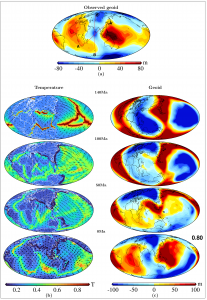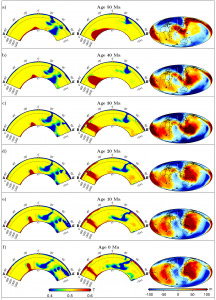Unraveling the mystery behind the Earth’s lowest geoid anomaly in the Indian Ocean
To the south of the Indian peninsula sits the world’s lowest geoid anomaly. The circular geoid low causes the surface of the Indian Ocean in that region to be depressed by more than 100 meters. A geoid can be thought of as the surface of the ocean without tides and waves. It is not a smooth surface, but is lumpy in nature, as it gets elevated or depressed depending on mass heterogeneities inside the Earth’s mantle. A geoid low would indicate a mass deficit deep within the Earth around that region. In a new study, using numerical models of mantle convection, Debanjan Pal and Attreyee Ghosh at the Centre for Earth Sciences (CEaS), IISc, figure out how the geoid low in the Indian Ocean could have formed.

The top figure shows the observed geoid. The bottom figure shows how the Earth’s
(b) surface temperature and (c) the geoid have evolved in our models starting
from 140 million years ago till the present day.

Evolution of temperature anomalies beneath the Indian Ocean and the geoid from 50 million years till the present day.
They begin 140 million years in the past and run the models forward in time till the present day. They find that plumes (hot buoyant upwelling rock masses) in the vicinity of the geoid low that rise from the edge of the African LLSVP (a huge mass of dense ancient rocks of very peculiar nature sitting at the bottom of the mantle beneath Africa) are integral in generating this low. These plumes arose when the plate carrying the ancient Tethys Ocean sank to the bottom of the mantle and perturbed the African LLSVP. They found that the geoid low started taking shape about 20 million years ago as the plume in the southern part of the Indian Ocean started rising and spreading beneath the surface.
REFERENCE:
Pal D, Ghosh A, How the Indian Ocean geoid low was formed, Geophysical Research Letters (2023)
LAB WEBSITE:https://ceas.iisc.ac.in/author/attreyee-ghosh/





